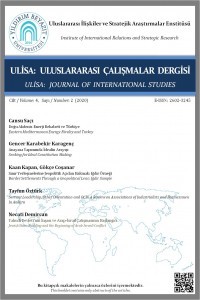İran Kürt Siyasi Hareketinde Öncü Aktör Olarak İran Kürdistan Demokrat Partisi
Etnik-ayrılıkçı motivasyona sahip olan silahlı gruplar, ilgili etnik grubun ve kimliğin temsilciliği iddiası ile birlikte “koruyuculuk” ve alternatif bir “siyasal yapı inşacılığı” imajlarını da yansıtmaya çalışmaktadırlar. Bu bağlamda etnik-ayrılıkçı silahlı gruplar bu çeşitlilik içerisinde sürekli bir rekabet içerisinde bulunmakta; sahip oldukları ideolojik temel ve siyasal hedefin ilgili etnik grup açısından en ideal form olduğunu, ilgili etnik grubun “koruyuculuğu ve temsilciliği” adına yegane aktör olduklarını savunmaktadırlar. İran Kürt siyasi hareketi ve İran Kürdistan Demokrat Partisi (İKDP) söz konusu teorik çerçeve düzleminde ortaya konulan dinamiklerin önemli bir örneklem alanını temsil etmektedir. Bu çalışmada, İran Kürt siyasi hareketinde 1940’lı yıllardan itibaren öncülük konumuna sahip olan İKDP, tarihsel, ideolojik ve yapısal boyutları ile ele alınmakta ve betimleyici bir yaklaşımla sunulmaktadır.
Anahtar Kelimeler:
İran, Kürt Siyasi Hareketi, İKDP, Öncü
The Iranian Kurdistan Democratic Party as a Leading Actor in the Iranian Kurdish Political Movement
Armed groups with ethnic-separatist motivations try to reflect the images of "protectionism" and an alternative "political structure", along with the claim of representing the relevant ethnic group and identity. In this context, ethnic-separatist armed groups are in constant competition within this diversity; They argue that the ideological basis and political goal they have is the most ideal form for the relevant ethnic group, and that they are the only actor in the name of "protection and representation" of the relevant ethnic group. The Iranian Kurdish political movement and the Democratic Party of Iranian Kurdistan (DPIK) represent an important sample area of the dynamics revealed in the theoretical framework. In this study, the IKDP, which has been a pioneer in the Iranian Kurdish political movement since the 1940s, is discussed with its historical, ideological and structural dimensions and presented with a descriptive approach.
Keywords:
ıran, Kurdish Political Movement, DPIK, Pioneer,
___
- Ahmadzadeh, H. ve Stansfield, G. (2010). The Political, Cultural, and Military Re-awakening of the Kurdish Nationalist Movement in Iran. Middle East Journal, 64(1), 11-27.
- Ahmedi, İ. (2018). The Stateless and Why Some Gain and Others not: The Case of Iranian Kurdistan, Emel Elif Tugdar, Serhun Al (Ed.), Comparative Kurdish Politics in the Middle East içinde (s. 201-235). New York: Palgrave Macmillan.
- DIS. (2013). Iranian Kurds: On Conditions for Iranian Kurdish Parties in Iran and KRI. Copenhagen: Danish Immigration Service.
- Eagleton, W. (1989). Mahabad Kürt Cumhuriyeti 1946. M. E. Bozarslan. (Çev.). Almanya: Komkar Yayınları.
- Ghaderi-Mameli, S. (2007). Kurds in the Islamic Republic: A survey. Michel Korinman, John Laughland (Ed.). Shiapower: Nexttarget Iran? içinde (s. 251-263). United Kingdom: Vallentine Mitchell& Colorado LTD.
- Ghazanjani, M. (2020). The Making And Unmaking of Kurdish Ethno-Natıonalism in Iran. Montreal: McGill University.
- Hassaniyan, A. (2021). Kurdish Politics in Iran: Crossborder Interactions and Mobilisation since 1947. Cambridge: Cambridge University Press.
- Heydari, G., Azhdari, B. ve Masomi, M. (2020). Kurdish Independence Aspirations and the Strategy of Israel and the United States to Weaken Iran’s Territorial Integrity. International Studies Journal, 17(65), 87-115.
- Kasımlo, A. (1980). İran Kürdistanı: İran Kürdistan Demokrat Parti 3. Kongre Belgeleri. Pekanin Yayınevi.
- Kasımlo, A. (2013). Çehl Sal-ı Mübareze der Rah-i Azadi. İran Kürdistan Demokrat Öğrenciler Birliği Yayını. https://tinyurl.com/3rpp4uka [Erişim Tarihi: 23.01.2022]. Koohi-Kamali, F. (2003). The Political Development of the Kurds in Iran. Palgrave Macmillan.
- Landinfo. (2017). Iran: Increased Kurdish Military Activity in Iran. https://tinyurl.com/2p97y6xv [Erişim Tarihi: 16.01.2022].
- Landinfo. (2020). PDKI - Democratic Party of Iranian Kurdistan. https://tinyurl.com/2p8bsycz [Erişim Tarihi: 02.01.2022].
- Masarat. (2016). The Kurdish Democratic Party of Iran Reappears after a 20-year hiatus: Is it a Realor an Imagined Threat to the Islamic Republic?. Saudi Arabia: King Faisal Center for Research and Islamic Studies (KFCRIS).
- Milburn, F. (2017). Iranian Kurdish Militias: Terrorist-insurgents, Ethno Freedom Fighters, or Knights on the Regional Chessboard? ETH Zurich Center for Security Studies. Monazzami, A. (2011). Ghassemlou's Ideas of Democracy and Iranian Kurdish Relations in Contemporary Iran. University of Troms.
- Nasri, G. ve Rezaie, D. (2020). The Most Significant Threats Against Security of the Islamic Republic of Iran from Kurdistan. Interdiciplinary Studies on Strategic Knowledge, 9(37), 168-197.
- O’Ballance, E. (1996). The Kurdish Struggle 1920-1940. New York: Palgrave Macmillan.
- PDKI. (2000). Programme. https://tinyurl.com/2p8ykh5w [Erişim Tarihi: 11.01.2022].
- PDKI. (2018). Bername ve Esasname. https://tinyurl.com/y4z4hv42 [Erişim Tarihi: 15.01.2022].
- Saleh, A. (2013). Ethnic Identity and State in Iran. New York: Palgrave Macmillan.
- Sharifi, S. (2014). The Possible Implementation of a Federalist Model and The Kurdish Claims to Self-Determination: A Comparative Study of Iran and Turkey. Stellenbosch University. Stansfield, G. ve Hassaniyan, A. (2022). Kurdish Insurgency in Rojhelat: From Rasan to The Oslo Negotiations. Middle Eastern Studies, 58(1), 153-166. Vali, A. (2011). Kurds and State in Iran. New York: IB Tauris.
- Vali, A. (2020). The Forgotten Years of Kurdish Nationalism in Iran. New York: Palgrave Macmillan. Veli, A. (2005). Kürt Milliyetçiliğinin Kökenleri. İstanbul: Avesta Yayınları.
- Yıldız, K. ve Taysi, T. (2007). The Kurds in Iran: The Past, Present and Future. United Kingdom: Pluto Press.
- Başlangıç: 2017
- Yayıncı: Ankara Yıldırım Beyazıt Üniversitesi
Sayıdaki Diğer Makaleler
Oyun Teorisi Bağlamında Suriye İç Savaşı'nın Geleceği
Mustafa Kürşat ŞAHİNER, Fatih Cemil ÖZBUĞDAY
Türkiye’de Göçmen Kaçakçılığının Hukuki ve Ekonomik Açıdan İncelenmesi
Alişan BALTACI, Zeynep Müjde SAKAR
İran Kürt Siyasi Hareketinde Öncü Aktör Olarak İran Kürdistan Demokrat Partisi
